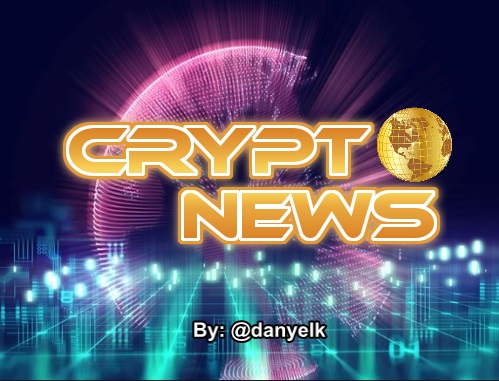Your Crypto News on Steemit November 11, 2017

- FlightChain: Blockchain Solution for Flight Data!
- Blockchain Revolution in the Energy Sector?
- Chia: Why the Bitcoin Alternative should be better for the Eco Environment!
- Canadian Police warns of Bitcoin Tax Scam!
- Citigroup CEO: States will respond to Bitcoin with their own Cryptocurrencies!



The Société Internationale de Télécommunication Aéronautique (SITA) is currently working on a blockchain solution for collecting, storing and distributing flight data. In their white paper, the non-profit organization explains that they are developing FlightChain to collect and reconcile data using smart contracts.
The process, in which the cooperative founded in 1949 works, refers to workflows known as Flight Data Monitoring. Data is collected using flight data recorders to test the efficiency of aviation workflows. These data are not personal, they represent the "aircraft perspective" and are in black boxes.
The problem that arises when storing the data in the different black boxes is obvious. Not only is there too much data, these are sometimes stored multiple times. In addition, accessibility is made considerably more difficult for other parties due to the centralized storage at the different companies. Also, the comparison of data to collect statistics is more difficult than necessary.
FlightChain is designed to make collecting data easier
The blockchain technology should now remedy. Decentralized storage of data makes them more accessible to all parties. As a topping, the comparison of data can be done through the use of smart contracts, which greatly facilitates the workload. In collaboration with British Airways and Heathrow, Geneva and Miami Airports, SITA has been working to develop and test Smart Contracts.
With FlightChain the flight data are stored and tested for possible contradictions. The system runs on both the Ethereum and Hyperledger fabric blockchain. The project is designed to test the effectiveness of the technology, which is why they chose the flight data. Mainly because they are non-sensitive data that most companies in the airline sector are interested in comparing.
Currently, SITA is still driving more airlines for FlightChain and designing a business model to drive development. Already last year, SITA dealt with the blockchain technology. Together with the start-up ShoCard, they have worked on a system to more effectively match the identity of passengers at airports.


Bitcoin, Ethereum, ICOs. The subject of blockchain and the currently most popular application cryptocurrencies are experiencing an ever-increasing media interest. However, in addition to being used as a digital currency or crowdfunding tool for start-ups, blockchain technology also offers exciting opportunities in other industries, e.g. the energy industry.
Global changes in the energy industry
The Paris Agreement on Climate Change, which came into force in November 2016, is essentially an agreement for the transformation of the global energy system. Transforming the energy sector, which accounts for around 2/3 of global greenhouse gas emissions, is essential to achieving the agreed goals. In 2014, around 80% of the world's primary energy was generated from fossil fuels (oil, coal, gas).
In addition to the global energy transition that has now begun, there is also a turnaround in capital, meaning that capital flows are moving away from fossil fuels to regenerative energies. The interesting thing is that it involves a process of distribution and democratization, not just investing more major investors (such as investment banks) in centralized fossil generation, but also increasingly investing private individuals in decentralized, clean micro-power plants such as photo-voltaic system. The decline in unit costs for PV modules, wind turbines and batteries will continue this development.
Challenges for the existing system in Germany and Austria
The energy industry in Germany and Austria is undergoing something like a double transformation at the moment: In addition to the energy transition, digitization is changing existing business areas and the foundations of our previous value creation - the energy transition is the largest IT project of all time and will only be successful in combination with digitization be.
Across countries, more than 1.5 million regenerative, mostly decentralized generation plants have to be integrated and controlled into the existing system. In order to reconcile the fluctuating feed-in of photo-voltaic and wind power plants with the energy demand, the use of digital technologies is necessary. In addition, a state-of-the-art infrastructure must continue to be created that will enable a real-time energy industry in the future. This is where blockchain technology comes into play.
Blockchain as a game changer in the energy industry?
In the future, millions of producers and consumers will need to communicate in real time, sharing not only information but also (digital) values. All of this has to be automated, because for reasons of time and money it is not possible for people to manually execute such transactions. Smart contracts that perform simple if-then functions will play a big role here.
An example: the energy supplier of the future can organize its energy deliveries and the financial settlement with the customer via the blockchain. Every kilowatt-hour (kWh) the customer receives from the utility is paid for in real-time via a digital wallet - tamper-proof, transparent, and at a minimal transaction cost. If the customer does not meet his payment obligations, the energy supplier can automatically stop the energy delivery - provided that the relevant contractual agreements exist.
Blockchain technology is already being used to charge electric cars. The company innogy cooperates with the Saxon start-up slock.it to simplify the charging of electric cars around the world. The project called Share & Charge aims to develop an authentication, loading and payment infrastructure. The exact amount of energy needed for the load is stored tamper-proof in the blockchain and billed at close to zero transaction costs. The interesting thing is that there may be many more applications in the future, eg. Charging drones on private charging points. Amazon is already planning to deliver smaller goods through drones. These could load their batteries on such decentralized charging points on their way to the respective customers, pay the owner via a cryptocurrency and then continue their delivery.
Above all, the blockchain will lead to a democratization of the energy world, since this technology will result in completely new business models. The technology primarily strengthens decentralized players such as household customers who consume and produce energy at the same time - so-called prosumers. In the future, they will be able to sell their energy surplus to their neighbors or other network participants automatically, thus generating additional income. In the optimal case, the selling price for each kilowatt hour would be higher than the current feed-in tariff, but lower than the purchase price from the utility's public grid.
Technical and regulatory challenges
With all the hype surrounding blockchain technology, there are still many challenges for a mainstream application in the energy industry. From a technical point of view, there is currently no blockchain capable of processing millions of transactions in real time. Furthermore, the future energy industry is unlikely to use a public blockchain with a proof-of-work validation process, as it is far too energy and cost intensive. The Bitcoin network has an installed capacity of about 1000 MW, which is about the same as a nuclear power plant. One of the main concerns of actors in the current energy industry is security of supply, since a reliable energy system is the basis for the prosperity of an economy. In contrast to the financial industry, the underlying energy must always be considered in the energy sector.
From a regulatory point of view, you are currently in the gray area. Neither the German Energy Industry Act (EnWG) nor the Austrian Electricity Industry and Organization Act (ElWOG) describes regulations for a blockchain application in the energy sector. For example, prosumers would become energy suppliers and would have to send generation forecasts to network operators and make financial adjustments for daily deviations.
Outlook
Digital technologies like Blockchain alone will not revolutionize our current energy system, but rather act as enabling instruments. Combined with falling prices for renewable generation technologies, batteries, higher computing power and cheap storage, the future energy system will be more automated, more efficient, cleaner and more democratized than it is today. We are facing exciting times.


Bittorrent inventor Bram Cohen wants to solve several problems of Bitcoin with Chia: The cryptocurrency should consume significantly less power and at the same time be safer.
Chia: A green alternative to Bitcoin?
On November 8, 2017, Bitcoin has reached its new high of more than $ 7,800. However, the continuing success of the cryptocurrency is also calling critics on the scene. Increasingly, the extremely high energy consumption in mining is problematized. This is exactly the problem Bram Cohen, the inventor of the Bittorrent protocols, wants to solve with a new cryptocurrency called Chia. It should, by the way, be better protected against possible centralization.
Like Bitcoin, Chia is based on a blockchain. In contrast to the investor darling, the individual blocks at Chia, however, are not generated by complicated, compute-intensive and thus ultimately not very environmentally friendly calculations. Instead, Chia uses a combination of two techniques: the proof of space and the proof of time. The proof of space uses memory functions instead of CPU-bound functions like Bitcoin. The advantage: memory is cheap and the power consumption is much lower.
The system itself would, according to Cohen, be vulnerable to possible attacks. Therefore Chia should alternate between proof of space and proof of time. The proof of time is a verifiable delay algorithm. In Chia, the beginning of each block is to be created by means of a proof of space and then finalized with the help of the proof of time.
Chia is due to appear in 2018
Currently there is not much to see except the basic explanation of the principle of Chia. Cohen has teamed up with early bitcoin exchange Tradehill’s COO Ryan Singer and they’ve raised a seed round for Chia to ramp up hiring, but he does not disclose its height. There will be a first token sale in the second quarter of 2018. The actual cryptocurrency will, according to the current state of planning, not be available until the end of 2018. Then it will have to show whether the currency can hold its promises and whether investors are even interested in supporting a greener cryptocurrency.
The idea is not really new because with Burst coin there is already a cryptocurrency that works with proof of space (POS). Nevertheless, it is nice to see that in the future there will be one more cryptocurrency, which is based on proof of space and thus more eco environmentally friendly than most cryptocurrencies.
Disclaimer:
The information presented in this post is not a recommendation for purchase or sale. It is only an opinion of me the author. They serve merely to describe the project and are not to be understood as an investment analysis.


The Canadian police have issued a warning against Bitcoin tax fraudsters. The police were committed to such a warning after more than 40 residents of the York region became victims of fraud.
According to a report by CBC News, the regional police of York said that the victims have suffered a loss of up to 340,000 Canadian dollars (267,000 US dollars) from the fraud. The fraudsters, who pretended to be employees of the Canada Revenue Agency, threatened the victims with a prison sentence for unpaid taxes. They called on fraud victims to transfer the alleged penalty over Bitcoin ATMs.
Refund unlikely
Police officer Rob Vingerhoets said that the Bitcoin ATMs are "legal", but that does not change the fact that it is extremely difficult or impossible to trace back the cryptocurrency. Therefore, to find the fraudsters or even get back the lost money, they think is unlikely.
According to police, there have been increasing reports of such fraudsters in recent months. Creating public awareness is the only way to fight such scams in the future, Vingerhoets said, adding:
The York Police have deployed flyers near Bitcoin ATMs to inform the public about potential frauds. The news comes shortly after the Durham regional police in Ontario warned the public against fraudulent investment plans with Bitcoin.


States will respond to Bitcoin with their own cryptocurrencies, as Citigroup CEO Michael Corbat is sure. In a recent interview with US economic news broadcaster Bloomberg, the New York banker said it was particularly concerned about the risks and control vacuum that states see in Bitcoin and other cryptocurrencies. However, he did not want to deny his great potential for the digital alternative currencies.
More and more big banks publicly recognize the potential of cryptocurrencies. Goldman Sachs CEO Lloyd Blankfein and ECB Director Benoît Cœuré have already stressed over the past few weeks that Bitcoin is being taken seriously, as Citigroup CEO Michael Corbat commented yesterday on the future of cryptocurrency. On a panel of the US economic news broadcaster Bloomberg he said he was convinced of the "burgeoning" technologies.
Asked if his bank is already facing customer demand for blockchain and crypto technology, the 57-year-old responded cautiously. The demand is still limited and rather concentrated. Currently, the Bitcoin is still "bulky".
Nevertheless, one should not turn away from technology.
Michael Corbat added:
With annual revenues of just under $ 70 billion, Citigroup, along with 30 other major global banks, is considered by the Financial Stability Board FSB to be of particular importance to the world financial system. In addition to Bank of America, JPMorgan Chase and Wells Fargo, it is one of the four largest banks in the United States.
States will not let the butter be taken from the bread
Away from its own business, Corbat still painted a bleak future scenario for Bitcoin. On the one hand, western regulators are trying to grow cryptocurrencies without being influenced and to tap potentials. On the other hand, because of the risk that it might turn out to be a potential economic disruption in the area of money laundering, states would not let the butter be taken from the bread.
Therefore, he does not believe that states take the influence of other non-state actors in the field of taxation on the light shoulder.
Corbat is confident in the interview:
No a shot in the dark
Looking at the news, Corbat's predictions are not a shot in the dark. For perceived risks and lack of government intervention have already inspired the thoughts of regulators in several countries and led to the birth of their own digital currency alternatives.
As I reported in October, according to media reports, about the government of Dubai is planning its own state crypto currency under the name emCash.
Likewise, Russian President Vladimir Putin had announced the release of a state-controlled crypto-ruble in October.
After all, even among the EU member states, the idea of state cryptocurrencies is not new. As I also reported, in August, the Director of the Estonian e-Residency program, Kaspar Korjus, proposed using estcoin as the digital national currency. However, this was met with strong headwind by ECB President Mario Draghi.
At least with regard to the western hemisphere and Europe, corresponding advances are thus still reserved for the imagination.

I wish you all a lovely Saturday and a great Weekend!!!
ⓁⓄⓥⒺ & ⓁⒾⒼⒽⓉ
Best regards
@danyelk
.gif)


Really informative information by you always active man you are in crypto world i always follow you beacause you are my senior thanks a lot
Thank you and your welcome I am glad you follow my news :)
img credz: pixabay.com
Nice, you got a 13.0% @minnowbooster upgoat, thanks to @danyelk
Want a boost? Minnowbooster's got your back!
The @OriginalWorks bot has determined this post by @danyelk to be original material and upvoted(1.5%) it!
To call @OriginalWorks, simply reply to any post with @originalworks or !originalworks in your message!
Great info :D
Thank you :)
Congratulations! This post has been upvoted from the communal account, @minnowsupport, by danyelk from the Minnow Support Project. It's a witness project run by aggroed, ausbitbank, teamsteem, theprophet0, someguy123, neoxian, followbtcnews/crimsonclad, and netuoso. The goal is to help Steemit grow by supporting Minnows and creating a social network. Please find us in the Peace, Abundance, and Liberty Network (PALnet) Discord Channel. It's a completely public and open space to all members of the Steemit community who voluntarily choose to be there.